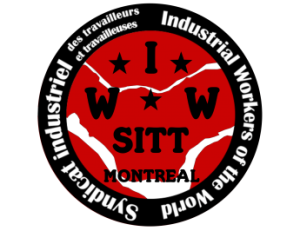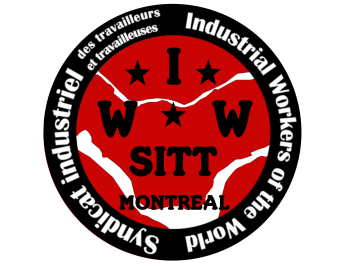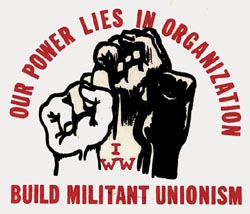Let's take action !
Owen King discusses the importance of tackling specific demands early in a campaign.
Unlike most unions, the SITT-IWW does not ask its members to go through the courts to obtain justice. Legally speaking, bosses never have an interest in having a union set up in their company. Several organizers in campaigns at Amazon and Starbucks were fired because of their union activity, even if the right to unionize is protected by law. In these two situations, the National Labor Relations Board (NLRB) took a long time to react; in the case of the campaign at Amazon, judge ruled in favor of organizer Gerald Bryson, who was fired, but only after warehouse workers voted in favor of the union. If these campaigns lasted, it’s really because organizers continued to mobilize their colleagues, not because the law was on their side
Since workers cannot count on laws to protect them, the objective of OT101 is to teach them to build collective power with their colleagues: putting pressure on the boss, by disrupting production in the workplace, by eating into profits, or even by appropriating the power exercised by the boss. This is because it teaches us to rely on our own abilities, those of our colleagues and those of our committee instead of depending on lawyers and bureaucracy that this training is difficult.
Media rarely feature stories of union organizing, which complicates our task; we don't have many examples to illustrate our points. And even when journalists talk about workers' struggles, They will talk much more about elections and legal conflicts than about strikes and direct actions. Jonah Furman's latest weekly newsletter («Who Gets the Bird ») is a good example: the section on strikes is at least half as small as that on elections in one of the big national unions, even if the author took the time to do his research. It is even rarer to see stories of employees who succeed in changing things in their workplace without negotiating a collective agreement or who do something other than strike. (like signing a petition or making a march on the boss).
This lack of examples of direct actions carried out by workers also complicates the task of the organizing committees which followed OT101 when the time comes to gain the trust of their colleagues in order to carry out the first direct actions of a campaign. In all workplaces, you will find people ready to join and build the union the first time they are contacted by the committee; in fact, most SITT-IWW organizing committees take shape when these people come together and follow OT101. But there are also people who could be led to join the union after discussing it with a committee member., and this is where the lack of examples poses a problem. Finally, there are people who need to see direct action taking place successfully in their workplace to be convinced to sign their card. These categories are described in detail in the section Know the Union, Hear the Union, See the Union of text Weakening the Dam (“Weaken the dike”). I can say from experience that most workers fall into one of the last two categories: They need to “hear about the union” and “see the union” in action to become interested in it.
In a campaign focused on direct action, you can't just tell your colleagues that the law protects their right to organize with their colleagues to defend their interests or that signing a membership card is enough to support their local union. You must prove to them that collective action can lead them to victory. This means they will have to get into the ring, with workers in one corner and bosses in the other. If you fail to take direct action successfully, you may not be able to convince the majority of your colleagues to really get involved. If your committee does not take action in the early stages of the campaign, your limbs risk getting stuck in a fatal gear.
The fatal gear
The goal of OT101 is to learn how to build a committee. Several steps must be followed before taking action: find the contact details of your colleagues, meet them face-to-face and assess their engagement, do social mapping of the workplace, etc. However, it happens that the development of the committee comes at the expense of direct action.. This becomes problematic if, for example, the committee prefers to recruit more colleagues than confront their boss. If they did not follow OT101, committee members could invite colleagues they have only spoken to a few times to come to a committee meeting, and try to convince them to join the union during the meeting.
A priori, there is nothing wrong with wanting to recruit more members. Workers need strength in numbers, and a large committee allows this force to be channeled. That said, committees sometimes fall into a dangerous trap: they will not take action until they have enough members, but they cannot recruit new members if they do not take concrete actions. If you organize yourself solely with the aim of establishing a balance of power when negotiating a contract, it won't be a problem; in this scenario, direct action is seen as a last resort if you cannot reach an agreement. In our vision of things, On the other hand, we view direct action as a way to give confidence to your colleagues and their committee.
If committee members fail to mobilize in direct actions, the campaign may hit a wall. If this does not lead to any concrete action or victory, the organizers will become discouraged, leave the committee and maybe even quit their job. Consequently, committee members will start using one-on-one meetings to recruit new members instead of taking the time to talk with colleagues about their problems and ways to overcome them. Since the committee will no longer be able to attract more members than those who already know the union, the campaign will die down once all these people have joined the union, will have exhausted themselves with the task and will have ended up leaving.
How to fix this problem?
To get out of this vicious circle, a specific problem needs to be addressed. We already take precautions to avoid negative repercussions from our small actions, for example by ensuring that committee members do not reveal the existence of the union or hold meetings with colleagues who are not involved. On the other hand, an action can be a success even if it is only carried out with a minority of employees. In one of the campaigns where I was an external organizer, a committee of four workers managed to obtain salary increases and days off through small-scale actions. The administration asked employees what changes they would like to see in their workplace and the committee members, as well as a few other employees supportive of the campaign, presented the problems that the committee had deemed to be priorities. The bosses gave in to the demands (particularly those relating to salary and sick leave), but they never heard of the organizing campaign. Why? Because the committee members decided to tackle issues that their colleagues had at heart, that they involved those who were not part of the committee, and that they carried out direct action that seemed feasible to them in relation to a demand that they thought they could win.
If two people manage to coordinate a direct action that involves their colleagues, they form a more solid committee than a group of 10 people who do not take concrete actions. Since we did the action described earlier, we have 50% more colleagues who support the campaign and the committee has been completely renewed; new members have taken over, and the original members were able to take a break.
It is these small actions that, later, will give us the confidence to go on strike and assert bigger demands. Even this may seem complicated at first, it is up to the committee to establish its calendar according to its needs. Professional unions, on their side, are subject to conditions imposed by a third party, whether it is the date of the elections or the composition of the bargaining unit responsible for negotiating the collective agreement. Representatives will be elected (or not), and the collective agreement will be adopted (or not) : there are no half measures or wiggle room.
A small committee can win victories quickly or learn from mistakes. These victories can also allow the campaign to grow beyond a single workplace; in the case of the union I discussed earlier, committee members who won pay raises and sick leave became trainers for OT101 and act as mentors for external SITT-IWW organizers. They help other workers set up their own committees and achieve their first victories. This is how strong, supportive unions can take root across an industry.
Owen King is a SITT-IWW member and game industry organizer in Seattle.




Leave a Reply
Want to join the discussion?Feel free to contribute!